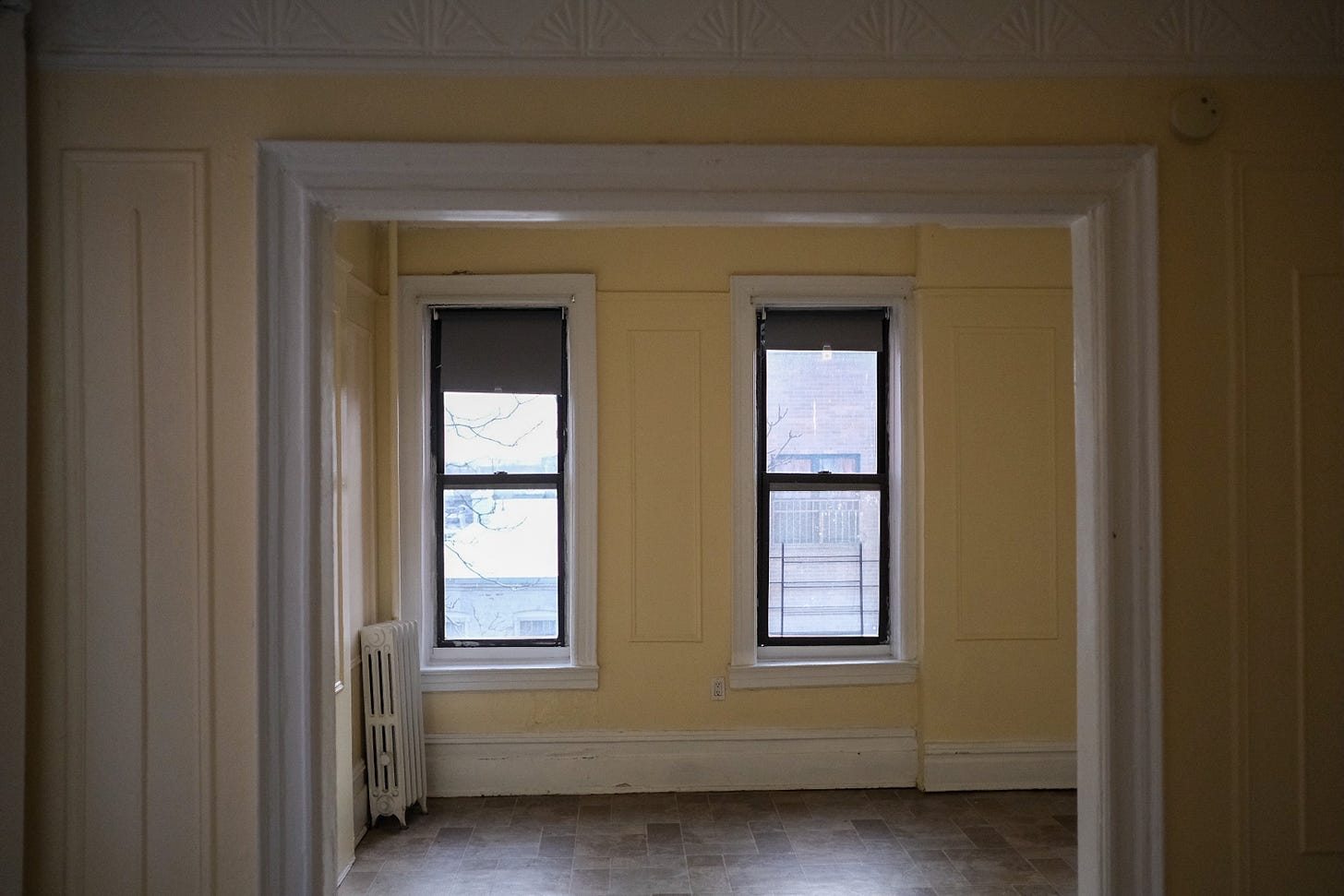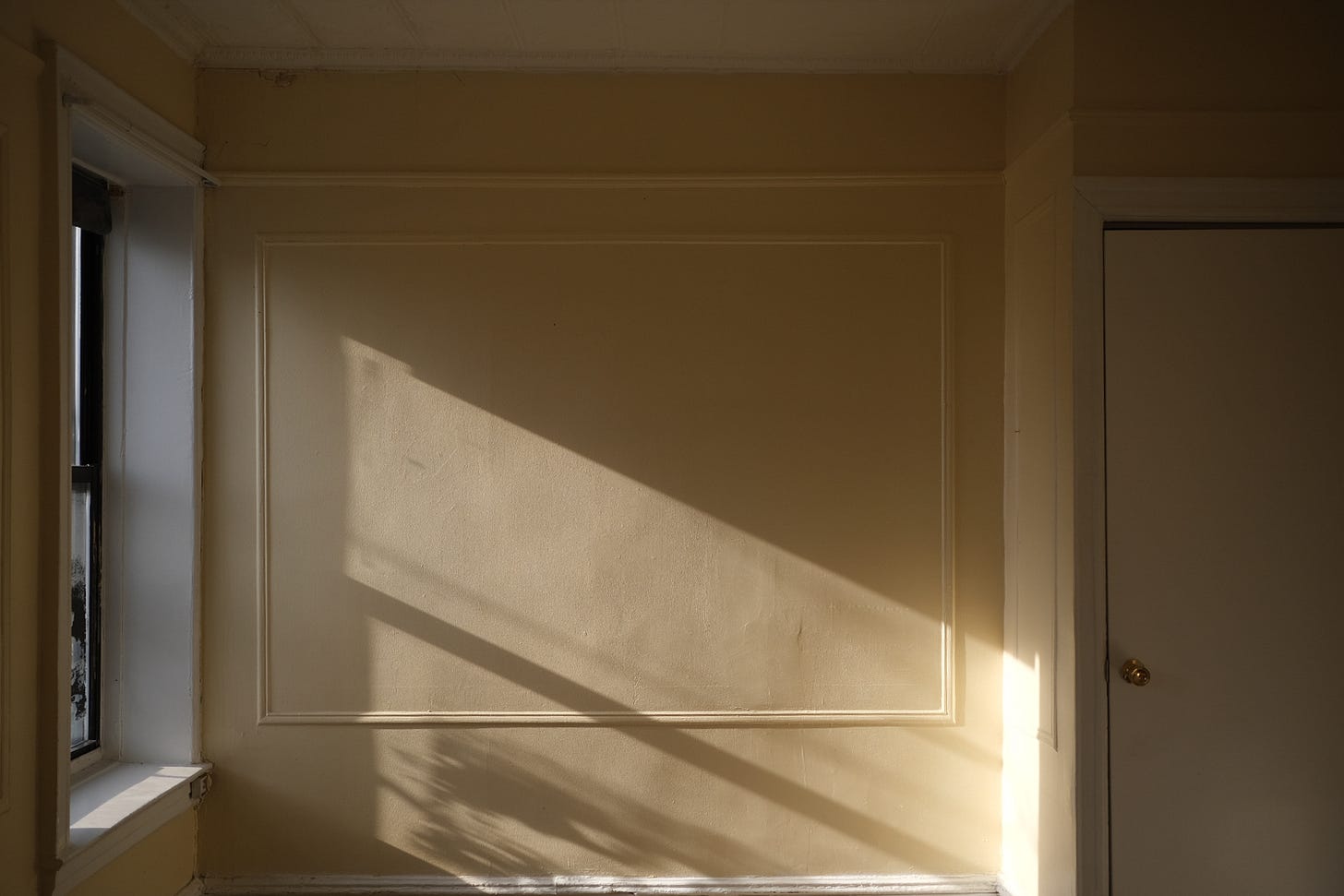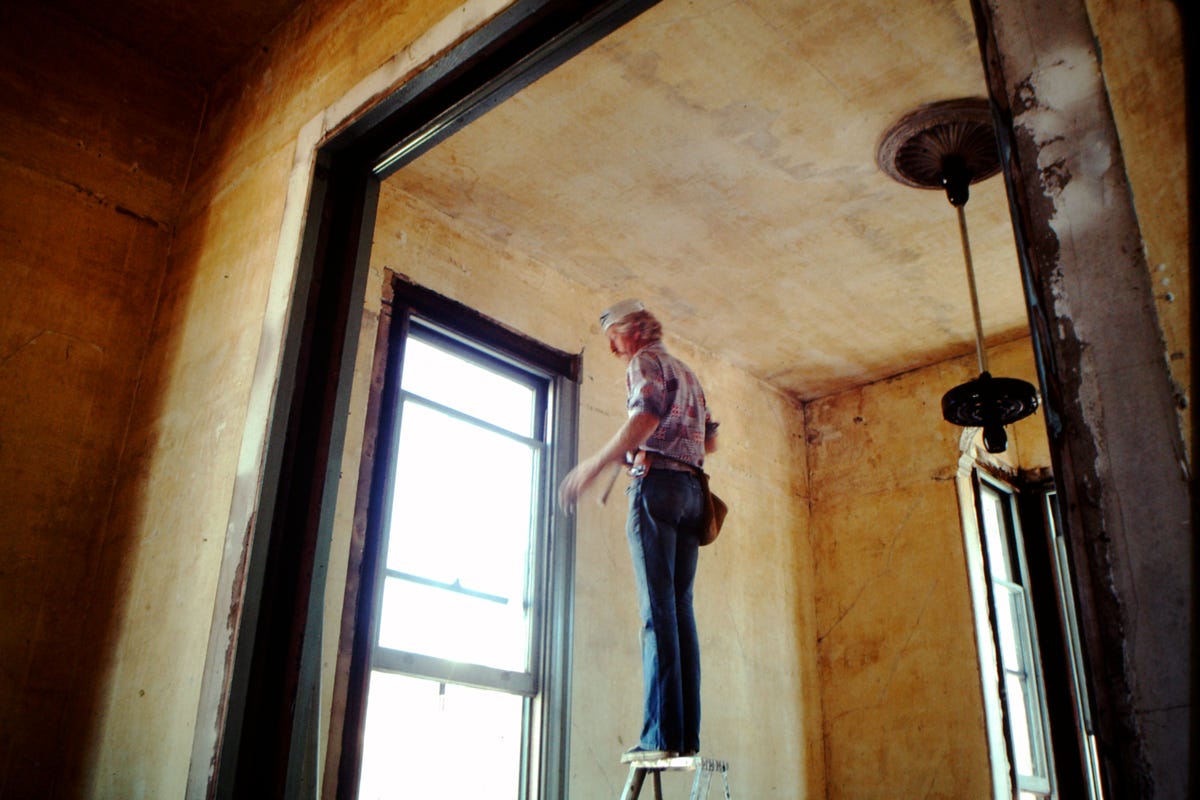Two weeks ago, I responded to a Craigslist advertisement for a modestly priced apartment in Sunset Park, Brooklyn. The listing contained no images, but read like free verse:
“Sunset Park Old School 1BR in Walk up Building. Wood floors, large kitchen (no dishwasher), large bathroom, large rooms (old school)”
The brief description was enough to justify an hour train ride down to meet Max, the broker who showed me the apartment.
Hello, I am Alex Wolfe and this is another edition of Pedestrian: a newsletter for people who like to walk. Thanks to all my patrons for your support. If you’d like to support this work, please consider becoming a member.
Upon my arrival, we walked up three flights of stairs, where he ushered me through a door labeled 3C.
“It’s no Taj Mahal, but for the price…”
Located in a 16 unit apartment building, south and east-facing windows lined the walls, which left the linoleum floors drenched in golden sunlight. Looking south towards Bay Ridge revealed a majestic view of the Verrazano Bridge – the longest suspension bridge in the United States – just two and a half miles away.
“People pay thousands of dollars for a view like this!”
It was clear Max wanted me to rent the unit – it’s his job after all.
Not so fast now. I’ve had my share of crummy apartments, (including one fire) and I wasn’t looking to add another to that list.
I proceeded to move through a series of inspections that I perform each time I look at prospective homes: I checked below the sink for traces of pest activity, scanned the ceilings (which I should mention were covered in ornate tin tiles) for signs of prior leaks, pressed on the walls to gauge how thick the sheetrock was separating me from my neighbors, flushed the toilet and turned on the shower to gauge the hot water, scanned the baseboard trim for gaps, and lastly, sat in silence for just a moment, waiting to hear the thumps of footsteps from an upstairs neighbor. Nothing.
While the unit needed some love, it emitted a cheerful energy – a wonderful sign. Passing my inspection, I turned to Max and smiled.
”I’ll take it.”
Afterwards, we walked to the broker’s office and I filled out an application. The next day, a Saturday, I was approved to rent the unit. The following Monday, I signed a one year lease, and a week later, spent my first night in the unit.
For the first time in my life, I’m living alone.
Prior to seeing the apartment, I took a walk with a friend through the West Village where he asked what my dream apartment would look like.
“There would be no walls or doors,” I replied.
Astutely, he responded, “you need a place to think.”
Since moving to the city, I’ve barely prioritized my living space. Time here has consisted of very few leases and many small apartments (often shared with a roommate or two) as a means of paying as little rent as possible.
Before living alone, I rented a room in a three bedroom apartment in Bed Stuy that consisted of no windows save for the skylight sitting directly above my bed. Every morning, I woke up facing the sky and folded up a twin size Japanese futon before hopping in the shower. A quarter of the room was taken up by a long desk, which is where I would sit when I needed to work. No more than 50 sq. ft, the room was best described as an office where I chose to rest.
As you can imagine, sitting in a windowless room for extended periods of time gets quite old. In response, I started working at a coffee shop in Manhattan, which I semi-jokingly called my “studio.”
For $3 – the price of a small coffee – I could spend my afternoon in the company of others. Open later than most coffee shops, the space has an abundance of seating, power outlets, reliable WiFi, and plenty of people to watch, however, it was not a sustainable option – even if the employees never questioned why I spent 3–4 afternoons there a week. I needed silence.
Another friend teased, “why not get your packages delivered there too?”
I could have easily continued living with roommates and rented out my own studio, but considering I am an artist with an immaterial practice (meaning I don’t produce objects) that occupies a certain space between art and life, I’ve long preferred to live where I work. Getting my own apartment just made sense.
Whether we live alone or not, space provides an opportunity to examine the thoughts churning inside of our heads (given that you can find some silence) and allows us to project them into the physical world. How we go about using the space is up to us, but it may be manifested in the ways we choose to decorate, arrange, and live.
Since moving into my own apartment, my life has not drastically changed…yet, but I can sense a feeling of ownership emerging that I’ve not felt before. Despite living in a rental, I’ve caught myself getting lost in menial household tasks, such as caulking the gaps beneath the baseboard trim, or wiping down my cabinets, unpacking my dishes, and placing them on the shelves. While I’m apprehensive about owning much, choosing what objects to introduce into my space, such as a sofa, feels akin to planning an exhibition at a gallery.
I’m reminded of the late artist David Ireland who, after a year of living in New York City, returned to California and settled in San Francisco, where he purchased a home at 500 Capp Street in the Mission District.
Shortly after moving in, he began implementing a 30 month “maintenance action” which consisted of removing window molding, stripping wallpaper, sanding surfaces, and coating the walls, ceiling, and floors with high gloss polyurethane to preserve and highlight his modifications.
Intending to use the home as a studio, he grew to see his house in a sculptural way – considering his activity as an artistic endeavor – not just a household renovation. Ireland’s 30 year residence at 500 Capp Street is considered the centerpiece of his prolific career.
“I reached a philosophical point where I realized that the lively presence I was looking for in my art was here on the walls, as I stripped away and cleaned off the surfaces,” Ireland stated in a 1981 interview. “Why do we have to fabricate a stretcher, a canvas—why not just make art out of an environment? I couldn’t go back to normal work.”
Given that it is winter, I’m spending less time walking outside and taking photographs. I have a tendency to be hard on myself when I’m not actively producing work, but Ireland’s artwork provides a sense of relief. It is a reminder that “everything is the work.”
While I wait for warm weather, I find solace in hanging the shelves above my kitchen table or getting a good night's rest. Since putting a table and chairs in my living room, I’ve discovered my new favorite activity: spending the evening looking out my south-facing windows.
Through the glass, I see a steady flow of traffic moving across the Verrazzano bridge. The car headlights move back and forth like a Coney Island amusement ride. If you look into the sky, there are more glowing lights, which could easily be mistaken for incredibly radiant stars, however it's just a series of passenger airplanes flying into the New York Metro. On particularly foggy evenings, if I sit in silence, I can hear the fog horns of shipping vessels moving through the New York Harbor.
While it is tempting, I’ll unlikely abandon a walking based practice in favor of fixing up my apartment or looking out the window all evening. Instead, while sweeping the floor of my kitchen, I’m reminded that everything is “the work” as long as we can give ourselves a little space to think. The walks will follow.
Thanks for reading,
–Alex
Sunset Park, Brooklyn
SUPPORT THIS NEWSLETTER
If you’ve appreciated reading Pedestrian in the past, enjoy it presently, and feel excited about upcoming projects, please consider supporting this project for as little as $5 a month. Thanks :)
As always, this is Pedestrian, a newsletter telling stories about the people, routines, and connections we make as a result of moving throughout one’s everyday surroundings.










The idea of maintaining/caretaking the space in which we dwell seems key to moving beyond the noisy trends of our current times.
What a wonderful perspective.